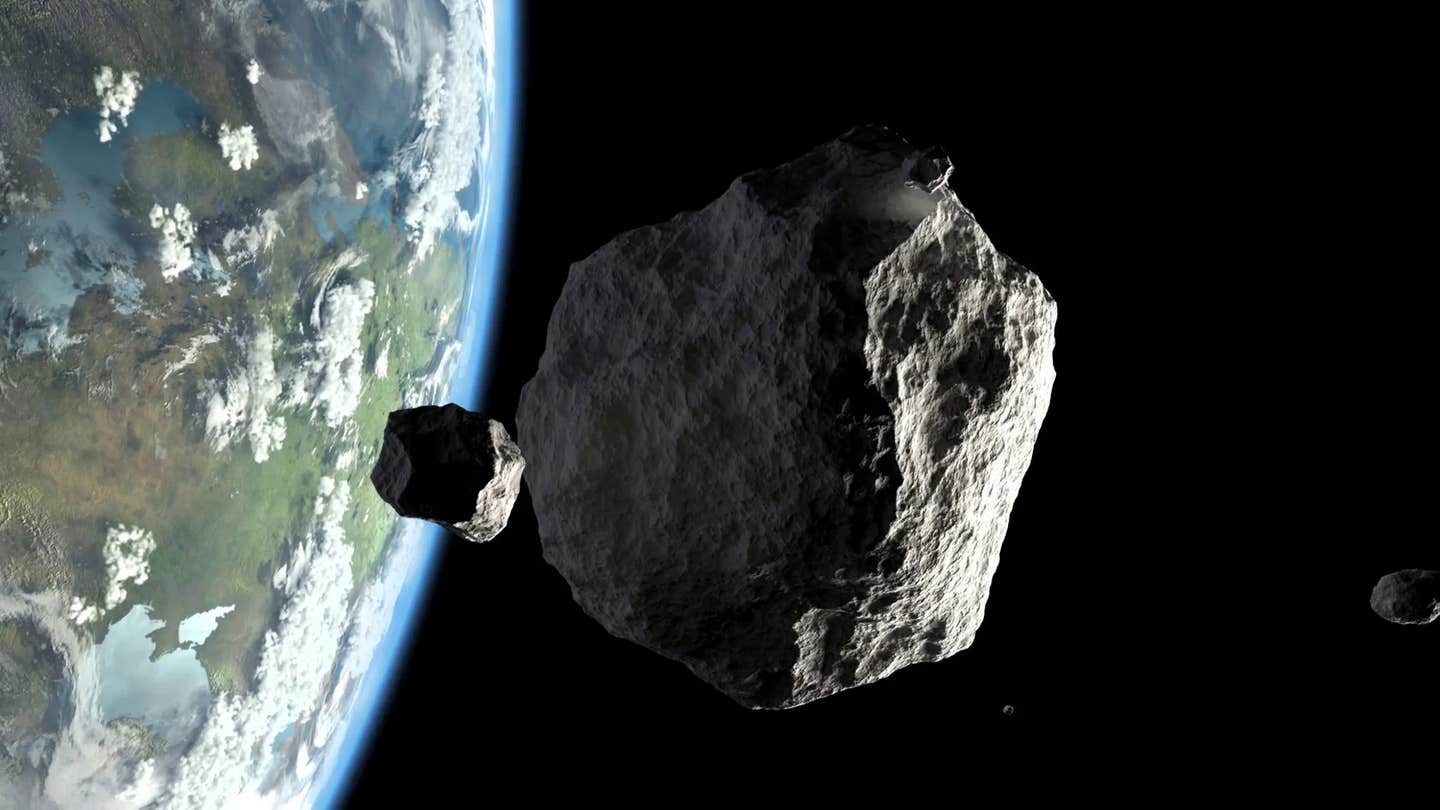The Earth is at risk of a city-killer asteroid strike in 2032
Astronomers have discovered a near-Earth asteroid, now known as 2024 YR4, that could potentially collide with Earth on December 22, 2032.

Asteroid 2024 YR4, dubbed a “city killer,” now has a 3.1% chance of striking Earth in 2032. (CREDIT: iStock)
In December 2024, astronomers discovered a near-Earth asteroid, now known as 2024 YR4, that could potentially collide with Earth on December 22, 2032.
Initially, the chance of impact was a mere 1%, but recent observations have raised the probability to 3.1% — the highest level ever recorded for a potentially dangerous asteroid. Although this translates to odds of about 1 in 32, there's still a 96.9% chance that the asteroid will safely pass by Earth.
However, the potential consequences are serious enough to warrant close monitoring. With an estimated diameter of up to 295 feet, this “city killer” asteroid could unleash energy equivalent to 8 megatons of TNT, about 500 times the power of the atomic bomb that destroyed Hiroshima. If it were to hit a populated area, it could wipe out an entire city, affecting millions of lives.
Why the Risk is Rising
The odds of an asteroid strike have been steadily increasing since YR4 was first detected. On February 7, 2025, NASA raised the impact probability from 1.2% to 2.3%, which later climbed to 2.6% before reaching the current 3.1%. This steady rise is due to refined calculations as scientists learn more about the asteroid's orbit.
The European Space Agency (ESA) has also been tracking YR4, placing the probability slightly lower at 2.8%. Despite the differences, both NASA and ESA agree that YR4 poses the highest risk of any known asteroid.
Richard Moissl, head of ESA’s Planetary Defence Office, explained, “The size of the uncertainty region has shrunk since then, because more is known about it, so Earth, remaining the same size, occupies a greater portion of the region than it did originally.”
This "uncertainty region" represents the area in space where the asteroid could be at the critical moment in 2032. As astronomers narrow down its location, they either confirm a lower risk or discover a higher one. The probability of impact could decrease to zero as more data becomes available, but for now, the uncertainty keeps the odds at a historic high.
Related Stories
The Torino Scale and Impact Potential
To assess the danger of asteroids, scientists use the Torino Scale, which ranges from 0 to 10. A score of 0 means no risk, while a 10 indicates a global catastrophe. Asteroid 2024 YR4 currently holds a rating of 3, meaning it has a chance of localized destruction. This rating is rare and is only given to objects with an impact probability greater than 1%.
At its current size estimate of 131 to 295 feet, YR4 falls into the “city killer” category. Bruce Betts, chief scientist for the nonprofit Planetary Society, explained, “If you put it over Paris or London or New York, you basically wipe out the whole city and some of the environs.”
This kind of impact could devastate cities like Mumbai, Bogota, or Lagos, which lie within its projected trajectory, endangering about 110 million people.
However, the asteroid is not large enough to cause a global catastrophe like the one that wiped out the dinosaurs. “This is not the dinosaur killer. This is not the planet killer. This is at most dangerous for a city,” reassured Moissl.
NASA and ESA are closely monitoring 2024 YR4 using a range of advanced telescopes, including the James Webb Space Telescope. By studying the heat emitted by the asteroid, scientists can more accurately estimate its size and trajectory. This information will help agencies like NASA and ESA determine whether any deflection measures are needed.
As more data is collected, experts believe the odds of a collision will drop below 1% before April 2025. After that, YR4 will move too far from Earth to be observed until it returns in four years. During this time, international space organizations will continue to update risk assessments and prepare for any potential threats.
Meanwhile, planetary defense agencies are exploring strategies to deflect or destroy hazardous asteroids. NASA's DART mission successfully demonstrated this capability in 2022 by intentionally crashing a spacecraft into the asteroid Dimorphos, altering its orbit. A similar approach could be used if YR4 remains a threat.
Preparing for a Low-Probability, High-Impact Event
Although the probability of a collision is still low, the potential consequences are significant enough to keep 2024 YR4 under close observation. Bruce Betts emphasized, “I’m not panicking. Naturally, when you see the percentages go up, it doesn’t make you feel warm and fuzzy and good.” Nevertheless, he remains confident that ongoing observations will eventually rule out any impact risk.
Moissl echoed this optimism, stating, “What will happen is, with our gaining knowledge, uncertainty will shrink further and further and further. And the expected case is that we will manage to shrink it so much that Earth is no longer inside this uncertainty region, and then the impact probability will drop to zero.”
While the chance of impact is the highest ever recorded for a potentially dangerous asteroid, it is important to remember that there is still a 96.9% likelihood that YR4 will miss Earth entirely. International space agencies are prepared and remain vigilant, ensuring that you can continue to look up at the night sky without fear — at least for now.
Recent Asteroid Strikes to Hit the Earth
In recent years, Earth has experienced several notable asteroid impacts. Here are some of the most significant:
December 2024 – Siberia Fireball: On December 3, 2024, a small asteroid approximately 70 centimeters wide entered Earth's atmosphere over eastern Siberia. It disintegrated harmlessly, creating a spectacular fireball visible to local residents. This event was particularly noteworthy as NASA astronomers detected the asteroid before its atmospheric entry, marking only the 11th time such early detection has been achieved.
September 2024 – Philippines Fireball: On September 4, 2024, a small asteroid designated 2024 RW1, measuring about 1 meter in diameter, entered Earth's atmosphere over the Philippines. It disintegrated near the island of Luzon, producing a bright fireball. Both the European Space Agency (ESA) and NASA had predicted this event, ensuring there was no risk to the public.
January 2024 – Berlin Meteor: On January 21, 2024, a small asteroid approximately 44 centimeters in size, designated 2024 BX1, entered Earth's atmosphere and disintegrated as a meteor over Berlin, Germany. Discovered just hours before impact by Hungarian astronomer Krisztián Sárneczky, this event marked the eighth time an asteroid was detected prior to impacting Earth. Fragments of the meteor, known as the Ribbeck meteorite, were subsequently recovered.
November 2022 – Ontario Fireball: On November 19, 2022, a small asteroid approximately 1 meter in diameter, designated 2022 WJ1, entered Earth's atmosphere over southern Ontario, Canada. Discovered three hours before impact by astronomer David Rankin at Mount Lemmon Observatory, the asteroid produced a bright fireball upon atmospheric entry. This event marked the sixth successful prediction of an asteroid impact.
December 2018 – Kamchatka Meteor: On December 18, 2018, an asteroid estimated to be between 10 and 14 meters in diameter exploded in an airburst over the Bering Sea near Russia's Kamchatka Peninsula. The explosion released energy equivalent to approximately 173 kilotons of TNT, making it the largest recorded asteroid impact since the Chelyabinsk event in 2013.
These events highlight the importance of continuous monitoring and early detection of near-Earth objects to assess potential threats and enhance our understanding of asteroid impacts.
Note: Materials provided above by The Brighter Side of News. Content may be edited for style and length.
Like these kind of feel good stories? Get The Brighter Side of News' newsletter.
Joseph Shavit
Head Science News Writer | Communicating Innovation & Discovery
Based in Los Angeles, Joseph Shavit is an accomplished science journalist, head science news writer and co-founder at The Brighter Side of News, where he translates cutting-edge discoveries into compelling stories for a broad audience. With a strong background spanning science, business, product management, media leadership, and entrepreneurship, Joseph brings a unique perspective to science communication. His expertise allows him to uncover the intersection of technological advancements and market potential, shedding light on how groundbreaking research evolves into transformative products and industries.



